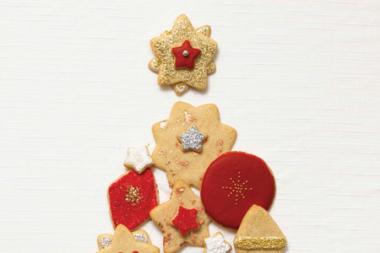The month of December is crowded with holiday parties and get-togethers, all filled with Christmas cookies. Another holiday tradition is the cookie exchange, when each member of a group of friends bakes a batch of cookies to be shared amongst the group. And cookies make great gifts, too.
Sweet treats have marked special occasions since before history was ever written down. The Christmas cookies and cakes we know today trace their roots to the Middle Ages, when traders brought spices and other novel foods back from their excursions to the East. Crusaders brought the spicy ginger root back from the Middle East, and gingerbread became popular shortly afterward, about the end of the 11th or beginning of the 12th century.
By 1500, many types of cookies with national variations were popular all over Europe. Gingerbread was probably the first cake or cookie associated with Christmas traditions. The first gingerbread men are said to have come from the court of Queen Elizabeth I, who made gingerbread likenesses of important visitors. Gingerbread houses may owe their popularity to the Grimm brothers’ fairy tale Hansel and Gretel, though some historians think the brothers may have been writing about an existing tradition when they described the house as made of bread, with a roof of cake and windows of barley, in the early 1800s. In any case, it is around that time that German bakers began creating elaborate houses with roofs of white icing, as well as other fancy gingerbread creations. Nuremberg, Germany became known as the gingerbread capital of the world, and by the 17th century only professional bakers were allowed to make the luscious, artsy gingerbread creations in Germany.
The English word cookie has Dutch origins, from Dutch settlers in North America during the 1700s. Koek is Dutch for cake, and became koekje, little cake, which then became cookie in English; the term first appeared in print in 1703. Cookies began to be mass produced, first in local bakeries and later, during the Industrial Revolution, in large factory bake houses. Tin cookie cutters became inexpensive and popular in the 1930s, giving rise to the many shapes of decorated sugar cookies associated with Christmas today.
The Holiday Cookie Exchange, where participants each bring a dozen or more of their favorite cookies to swap and leave with an assortment, is a relatively recent addition. Betty Crocker writes in the Cooky Book (1963): “A popular once-a-year party is the Christmas cooky swap party. Friends and neighbors gather, each bringing one dozen of her holiday specialty for each woman at the party. Cookies are set out to sample and admire and coffee is served. Afterward each one takes home a wonderful variety of festive cookies.”
Most folks have a favorite sugar cookie recipe that is rolled and cut into bells, stars, snowmen, Christmas trees and Santas, and decorated with red and green sparkles or icing. Mixing the ingredients is the easy part; rolling, cutting, and re-rolling dough that is too sticky or too dry is harder. For the perfect sugar cookie, make the dough well in advance of when you plan to make cookies, so you have time to chill it before you roll it. Cold dough is easier to handle. A good pastry cloth and a cloth rolling pin cover help, too. And the right amount and type of flour is important: too little and the dough is too sticky, too much and it is too dry to roll out. Don’t roll them too thin or they will crumble; a quarter inch is good.
Cookie dough will freeze well for four to six weeks wrapped tightly in plastic or in airtight containers. Bring it to room temperature before baking. You can also make cookies ahead of time and freeze them. Make sure cookies are completely cool before freezing, then wrap individually in plastic wrap and place in freezer bags or containers. If the cookies are frosted, freeze uncovered until they are firm, then wrap. Frozen cookies thaw fairly quickly at room temperature.
Whether you’re baking for yourself, your family, co-workers or guests, or for gifts, traditional baking makes for good eating, holiday cheer and pleasant memories.
Almond Cookies
Ingredients:
2/3 cup slivered almonds
1 1/2 cups flour
1 cup (2 sticks) butter
1/4 cup powdered sugar
1 teaspoon almond extract
2 eggs, separated
1/4 cup sugar or colored sugar sprinkles
Directions:
Preheat oven to 375 degrees. Separate eggs and set aside. With food processor knife attachment, chop half the almonds. Add flour, baking powder and powdered sugar; cut butter into this mixture with processor running. Add almond extract and 2 egg yolks with processor running. Dough should form a ball around the blade. Remove, wrap, and chill in the refrigerator for half an hour or longer.
Remove dough from fridge and roll out on pastry cloth approximately 1/4 inch thick. Cut into shapes. Brush with egg whites; sprinkle with sugar and remaining slivered almonds.
Holiday Oatmeal Treats
These healthy oatmeal cookies are made festive with cranberries.
Ingredients:
1 1/2 cup flour
1 teaspoon baking powder
1 teaspoon baking soda
1/4 teaspoon salt
1 teaspoon cinnamon
1/2 cup butter (2 sticks)
1 egg
1 teaspoon vanilla
2/3 cup sugar
1 cup fresh (or canned) pumpkin
1 1/3 cup rolled oats
1 1/3 cup dried cranberries
2/3 cup chopped walnuts
Directions:
Preheat oven to 375 degrees. Sift together flour, baking powder, baking soda, salt and cinnamon. Cut in butter using a pastry blender or food processor.
In bowl, beat egg with sugar and vanilla; beat in mashed pumpkin. Add flour mixture and stir to combine. With wooden spoon, stir in oats, cranberries and nuts to form a stiff dough. Drop half-inch dough balls with teaspoon onto a greased cookie sheet. Flatten with the back of the spoon. The smaller cookies will be crispier; larger ones will be chewy. Bake 15 minutes.
You may want to omit the cranberries and use them to decorate the cookies before baking.



